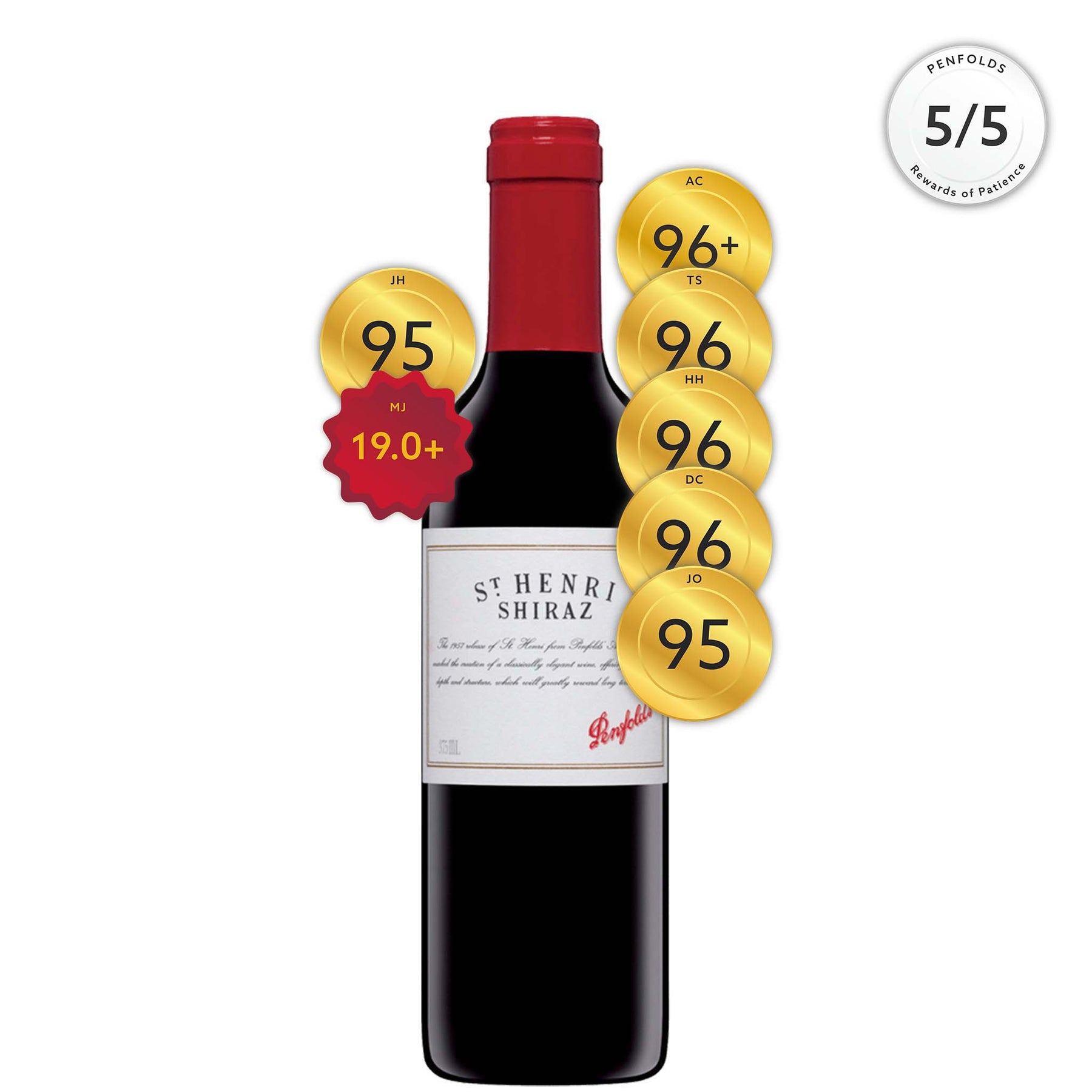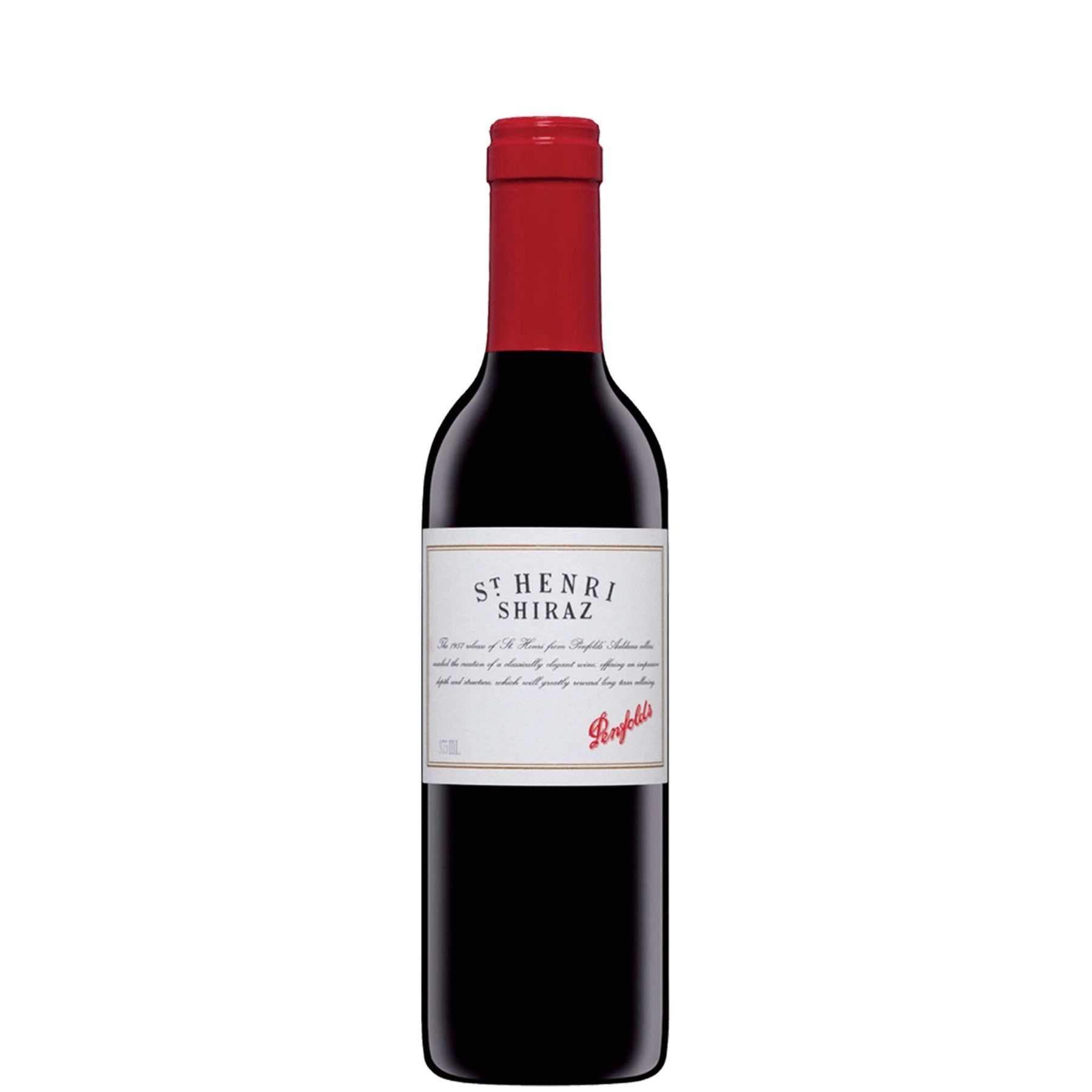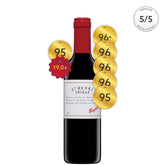

Penfolds St Henri Shiraz 2015 (375ml)
Style: Red Wine
Varieties: Shiraz (93%), Cabernet Sauvignon (7%)
Closure: Screwcap
Penfolds St Henri Shiraz 2015 (375ml)
Warehouse
34 Redland Drive
Vermont VIC 3133
Australia
Critic Score: 19/20 and 96
Alcohol: 14.5%
Size: 375 ml
Drink by: 2035
Penfolds Rewards of Patience tasting panel 2021 - 5/5 rating
St Henri is a time-honoured and alternative expression of Shiraz, and an intriguing counterpoint to Grange. It is unusual among high quality Australian red wines as it does not rely on any new oak. Released for the first time by Penfolds in the early 1950s (first commercial vintage 1957), it gained a new lease of life in the 1990s as its quality and distinctive style became better understood. Proudly, a wine style that hasn't succumbed to the dictates of fashion or commerce. St Henri is rich and plush when young, gaining soft, earthy, mocha-like characters as it ages. It is matured in old, 1,460 litre vats that allow the wine to develop, imparting minimal, if any oak character. Although a small proportion of Cabernet is sometimes used to improve structure, the focal point for St Henri remains Shiraz.
"The great 2015 season has yielded a wine of deep, dark, spicy fruit presence that entices from the outset. It's framed consummately in firm, fine tannin structure that propels its glorious fruit fanfare and promises effortless life in the cellar, lingering with undeterred line and great persistence." Tyson Stelzer
"The abiding character of St Henri is its longevity, particularly in the context of better vintages. It has none of the make-up of new American oak that can hide the imperfections of a lesser vintage. A great St Henri will come into its own in a bare minimum of 10 years, and live long thereafter." James Halliday
The 2015 Penfolds St Henri is a blend of 93% shiraz and 7% cabernet sauvignon from premium vineyards in McLaren Vale, Robe, The Peninsulas, Barossa Valley, Wrattonbully, Adelaide Hills and Mt Benson. It was aged for 12 months in 50+ y.o. large oak vats.
"Deep crimson. Intense dark cherry and dark chocolate aromas with elderberry, aniseed, herb garden and tobacco notes. Richly concentrated with dense elderberry, red cherry and mulberry fruits, plentiful chocolaty tannins and underlying mineral acidity. Finishes al dente, slightly grippy firm with lovely mineral length. Peak drinking 2023 to 2038.
Vintage Conditions: Rainfall in autumn and early winter were close to the long-term average in most of South Australia's main growing regions. However, the rain stopped abruptly in early August with only a few light spring showers recorded. September through to March saw record low rainfall, stretching water supplies. Warm and dry conditions during f lowering and fruit-set resulted in rapid grapevine growth and early flowering. During early summer temperatures dropped below average with no major heat waves recorded. The harvest progressed rapidly, with most blocks of shiraz picked earlier than usual. Although the conditions resulted in lower than anticipated yields, the quality of f ruit across the board was exceptional." Penfolds
Expert reviews
"Deep crimson. Intense dark cherry and dark chocolate aromas with elderberry, aniseed, herb garden and tobacco notes. Richly concentrated with dense elderberry, red cherry and mulberry fruits, plentiful chocolaty tannins and underlying mineral acidity. Finishes al dente, slightly grippy firm with lovely mineral length.. Peak drinking 2023 to 2038." Penfolds Rewards of Patience tasting panel 2021 - 5/5 rating
"With more grip and tannin and also more dryness and tang, St Henri is a beauty in 2015 and it looks back to its history with butcher's apron meatiness and smoke as well as looking forward with pristine redcurrant and prune tones reflecting the freshness and depth of this wine in equal measure. Superb and also impressively regal, this is a St Henri worthy of a reverential bow before you take a sip." Matthew Jukes – 19.0+/20 points
"Medium deep colour. Expressive inky dark cherry, dark plum, blackberry aromas with roasted walnut notes. Beautifully modulated wine with a core of dark plum, mulberry, blackberry fruits, fine plentiful slinky tannins and roasted walnut herb garden notes. Finishes graphite firm with superb length and inky complexity. Lovely density, volume and texture. Has the power and structure for long term aging. The sum may well prove to be greater than the parts, so wait a while. 14.5% alcohol – Drink 2025-2045." Andrew Caillard MW – 96+ points
"A St Henri of character, depth and room-filling exuberance. The great 2015 season has yielded a wine of deep, dark, spicy fruit presence that entices from the outset. It's framed consummately in firm, fine tannin structure that propels its glorious fruit fanfare and promises effortless life in the cellar, lingering with undeterred line and great persistence. Drink 2020-2030.” Tyson Stelzer, Wine Taste - 96 points
"Deep, bright red/purple colour with a bright, fresh-fruit aroma of blueberry, blackberry and spices, with a lick of aniseed and an earthy overtone. As usual, it lacks the charry-oak and graphite note that other Penfolds shirazes possess. A lovely soft, rounded, fleshy shiraz, which is supple and smooth and yet full-bodied as well, and structured for cellaring. Full-bodied and with a core of sweet fruit, this is a delicious shiraz. Succulent, indeed. I could drink it right now. Drink: 2018–2045." Huon Hooke, The Real Review - 96 points
"Described by Peter Gago as the antithesis of a 'show wine', Penfolds' much loved and admired St Henri Shiraz continues to plough its own furrow in glorious style. In many ways it is a superb counterpoint to the more senior Grange, having been aged in large, old oak vats. The nose here is cocoa powder and summer pudding with a touch of mocha. This segues onto a palate of red and black fruits, dark chocolate, graphite and liquorice. St Henris are usually built for the long haul thanks to their acidity, fruit and densely populated tannins, and this is no exception. Superbly structured, juicily vibrant, sweet and balanced, this is tempting to broach now. However, I'd leave it for a couple of decades and wait for the magic to unfurl. Drinking window: 2017-2040." John Stimpfig, Decanter – 96 points
"Spicy and fragrant, with a deeply ripened, earthy and meaty bouquet of dark fruits, dark flowers and cracked black pepper backed by smoky, mocha-like nuances. It's pristine and stylish, medium to fullish in weight, with a soft, penetrative core of black, red and blue fruits knit with a fine, firmish spine and wrapped with a mouthwatering acidity. Vivacious and elegant, it finishes with true length and savoury qualities. Drink: 2035-2045+." Jeremy Oliver - 95 points
"93% shiraz, 7% cabernet sauvignon from McLaren Vale, Robe, The Peninsulas, Barossa Valley, Wrattonbully, Adelaide Hills and Mount Benson, matured for 12 months in 50+yo large oak vats. Deep crimson-purple; an almost tarry note lurks in the blackcurrant, tapenade and earth of the bouquet; there is a torrent of flavour, richer yet cooler than many '15s. Drink by 2045." James Halliday, Halliday Wine Companion - 95 points
"Ah St Henri, the shy, elegant Penfolds red never sees a small oak barrel – a mainstay of the general Penfolds style – yet ages for decades and drinks beautifully. It's a favourite at Chateau Shanahan because it's always exciting. I rated the 2015 vintage among the top few wines of this year's release tasting: Deep with crimson rim; pure aroma of ripe, dark berries with a savoury overlay; juicy, fruit-packed palate, supple, sweet and intense; it's seductive but too young to drink yet with its deep fruit, savour and fine, firm structural tannins. Wow." Chris Shanahan
About st henri

The first vintage of St Henri – then Auldana Cellars St Henri Claret – was produced in 1888, beginning one of the most famous and enduring names in Australian wine. It was likely named after Auldana's winemaker Léon Edmond Mazure's son Henri or his wife, Philomine Henriette. The wine immediately enjoyed success, winning the Championship Cup for Best Claret in Australia at the Adelaide Wine Show in 1890 and then again as a joint winner in 1891. The St Henri label disappeared somewhere around the beginning of World War 1, probably because of reduced export sales. It was revived by Senior Red Winemaker John Davoren at Penfolds in 1953 to celebrate the centenary of Auldana Cellars (established by Patrick Auld in 1853) but the wine was not widely released. The 1953 release was made from Auldana and Paracombe fruit and the label design was based on original St Henri labels found in a loft at Auldana Cellars shortly after its sale to Penfolds in 1947.
According to retired Penfolds Senior Winemaker John Bird, the first vintages of St Henri were cabernet sauvignon and mataro blends. The fruit was foot stomped in open-ended hogsheads during vinification. After fermentation, the wine was matured in oak vats rather than hogsheads for around 18 months. John Davoren's aim was to make a wine in the traditional Claret style, accentuating fruit and maturation characters, rather than oak complexity. In this way the winemaking style differs to Grange, as it relies on larger seasoned oak vessels without any barrel fermentation. The 1957 vintage is officially recognised as the first St Henri commercial release under the Penfolds name. Nonetheless, John Davoren describes all of the 1950s vintages as "trials”. These experimental wines from 1953 to 1959 mark an important step forward for winemaking in Australia. Not only does St Henri honour the late 19th-century aspirations of Auldana's proprietor Sir Josiah Symon and winemaker Léon Edmond Mazure, but without the professional rivalry between Max Schubert and John Davoren, the Grange story would not have the same richness or romance. Initially St Henri achieved greater commercial success than Grange, although both were offered to the public as Claret styles. St Henri was a more elegant, approachable and familiar style because it reflected traditional winemaking techniques, whereas the revolutionary Grange was something of a blockbuster with more richness and fullness.
Today Penfolds St Henri is a multi-regional multi-vineyard South Australian blend, primarily based on shiraz, although it still honours the original style. Significant contrbutions of shiraz come from Barossa Valley, Eden Valley, Clare Valley, McLaren Vale, Langhorne Creek, Robe and Bordertown; cabernet sauvignon from Coonawarra, Barossa Valley and Adelaide Hills. After vinification the wine is matured in seasoned large oak vats for around 15 to 18 months before bottling.
St Henri was labelled 'Claret' until the 1989 vintage. Packaged in laser-etched bottles
since the 1996 vintage. Released in many markets under screwcap since 2005. St Henri Shiraz possesses a unique stature in the story of Australian wine. With its proven style and aging potential, it is a favourite among Penfold's collectors.
Extract from Penfolds Rewards of Patience tasting panel 2021
After the success of early sherries and fortified wines, founders Dr Christopher and Mary Penfold planted the vine cuttings they had carried on their voyage over to Australia. In 1844 the fledging vineyard was officially established as the Penfolds wine company at Magill Estate.
As the company grew, so too did Dr Penfold's medical reputation, leaving much of the running of the winery to Mary Penfold. Early forays into Clarets and Rieslings proved increasingly popular, and on Christopher's death in 1870, Mary assumed total responsibility for the winery. Mary's reign at the helm of Penfolds saw years of determination and endeavour.
By the time Mary Penfold retired in 1884 (ceding management to her daughter, Georgina) Penfolds was producing 1/3 of all South Australia's wine. She'd set an agenda that continues today, experimenting with new methods in wine production. By Mary's death in 1896, the Penfolds legacy was well on its way to fruition. By 1907, Penfolds had become South Australia's largest winery.
In 1948, history was made again as Max Schubert became the company's first Chief Winemaker. A loyal company man and true innovator, Schubert would propel Penfolds onto the global stage with his experimentation of long-lasting wines - the creation of Penfolds Grange in the 1950s.
In 1959 (while Schubert was perfecting his Grange experiment in secret), the tradition of ‘bin wines' began. The first, a Shiraz wine with the grapes of the company's own Barossa Valley vineyards was simply named after the storage area of the cellars where it is aged. And so Kalimna Bin 28 becomes the first official Penfolds Bin number wine.
In 1960, the Penfolds board instructed Max Schubert to officially re-start production on Grange. His determination and the quality of the aged wine had won them over.
Soon, the medals began flowing and Grange quickly became one of the most revered wines around the world. In 1988 Schubert was named Decanter Magazine's Man of the Year, and on the 50th anniversary of its birth, Penfolds Grange was given a heritage listing in South Australia.
Despite great success, Penfolds never rests on its laurels. In 2012 Penfolds released its most innovative project to date - 12 handcrafted ampoules of the rare 2004 Kalimna Block Cabernet Sauvignon.
Two years later, Penfolds celebrated the 170th anniversary – having just picked up a perfect score of 100 for the 2008 Grange in two of the world's most influential wine magazines. Today, Penfolds continues to hold dear the philosophies and legends – ‘1844 to evermore!'.

South Australia
South Australian is responsible for more than half the production of all Australian wine. It is home to more than 900 wineries across 18 wine regions. The regions are Adelaide Hills, Adelaide Plains, Barossa Valley, Clare Valley, Coonawarra, Currency Creek, Eden Valley, Kangaroo Island, Langhorne Creek, McLaren Vale, Mount Benson, Mount Gambier, Padthaway, Riverland, Robe, Southern Fleurieu, Southern Flinders Ranges and Wrattonbully.
Many of the well-known names in the South Australian wine industry established their first vineyards in the late 1830s and early 1840s. The first vines in McLaren Vale were planted at Reynella in 1839 and Penfold's established Magill Estate on the outskirts of Adelaide in 1844.
South Australia has a vast diversity in geography and climate which allows the State to be able to produce a range of grape varieties - from cool climate Riesling in the Clare and Eden Vallies to the big, full bodied Shiraz wines of the Barossa Valley and McLaren Vale. Two of Australia's best-known wines, Penfolds Grange and Henschke Hill of Grace, are produced here. There is much to discover in South Australia for the wine lover.



